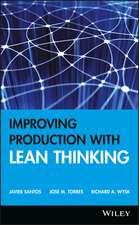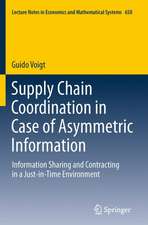Risk Management: How to Assess, Transfer and Communicate Critical Risks: Perspectives in Business Culture
Autor Antonio Borghesi, Barbara Gaudenzien Limba Engleză Hardback – 6 oct 2012
| Toate formatele și edițiile | Preț | Express |
|---|---|---|
| Paperback (1) | 489.04 lei 38-44 zile | |
| Springer – 9 noi 2014 | 489.04 lei 38-44 zile | |
| Hardback (1) | 637.59 lei 6-8 săpt. | |
| Springer – 6 oct 2012 | 637.59 lei 6-8 săpt. |
Preț: 637.59 lei
Preț vechi: 750.11 lei
-15% Nou
Puncte Express: 956
Preț estimativ în valută:
122.04€ • 132.61$ • 102.58£
122.04€ • 132.61$ • 102.58£
Carte tipărită la comandă
Livrare economică 22 aprilie-06 mai
Preluare comenzi: 021 569.72.76
Specificații
ISBN-13: 9788847025301
ISBN-10: 8847025303
Pagini: 148
Ilustrații: X, 142 p.
Dimensiuni: 155 x 235 x 14 mm
Greutate: 0.34 kg
Ediția:2013
Editura: Springer
Colecția Springer
Seria Perspectives in Business Culture
Locul publicării:Milano, Italy
ISBN-10: 8847025303
Pagini: 148
Ilustrații: X, 142 p.
Dimensiuni: 155 x 235 x 14 mm
Greutate: 0.34 kg
Ediția:2013
Editura: Springer
Colecția Springer
Seria Perspectives in Business Culture
Locul publicării:Milano, Italy
Public țintă
Professional/practitionerCuprins
Preface.- Part I Reference Theories.- Chapter 1 From Social and Natural Science Comes a Historical Overview on the Concepts of Uncertainty and Risk.- Chapter 2 Governance and Risk Management.- Chapter 3 Risk Management Perspectives.- Part II Risk Assessment: Approaches, Techniques and Good Practices.- Chapter 4 The Need for an Enterprise-Wide Approach to Risk Management.- Chapter 5 Risk Identification.- Chapter 6 Risk Analysis.- Part III Risk Treatment: Approaches, Techniques and Good Practices.- Chapter 7 Risk Treatment.- Part IV Supply Chain Risk Management and Business Continuity.- Chapter 8 Operational Risk and Supply Chain Risk Management.
Notă biografică
Antonio Borghesi is Full Professor at the Faculty of Business Economics at the University of Verona (Italy). Since he published his first publications in risk management in 1976, he has dedicated large time in creating and sharing the risk management culture and knowledge. He founded the Post Graduated Course in Risk Management and the LogiMaster – Master in Logistics and Supply Chain Management. He served as consultant in public and private companies, was member of RIMS (Risk and Insurance Management Society) – New York and other Risk Management organizations, Member of the ISO Working Group on the 31.000. He served as Director of the Department of Studi Finanziari Industriali e Tecnologici at the University of Verona. He is now an elected member of the Italian Parliament.
Barbara Gaudenzi is Associate Professor at the Faculty of Business Economics at the University of Verona (Italy). She is also Director of two post graduated masters at the Faculty of Business Economics in Verona (Italy): the Post Graduated Course in Risk Management and the LogiMaster – Master in Logistics and Supply Chain Management. Barbara has conducted extensive research on how companies assess and manage risks, within organizations and in their supply chains. She has published over 30 research and practitioner articles and books chapters, many of which focus on risk management and supply chain management. Barbara coordinates and is involved in research projects with companies and other organizations. She is member of the ISCRIM network (Supply Chain Risk Management Network) and Italian representative of the United Nations Environment Programme – Finance Initiative.
Barbara Gaudenzi is Associate Professor at the Faculty of Business Economics at the University of Verona (Italy). She is also Director of two post graduated masters at the Faculty of Business Economics in Verona (Italy): the Post Graduated Course in Risk Management and the LogiMaster – Master in Logistics and Supply Chain Management. Barbara has conducted extensive research on how companies assess and manage risks, within organizations and in their supply chains. She has published over 30 research and practitioner articles and books chapters, many of which focus on risk management and supply chain management. Barbara coordinates and is involved in research projects with companies and other organizations. She is member of the ISCRIM network (Supply Chain Risk Management Network) and Italian representative of the United Nations Environment Programme – Finance Initiative.
Textul de pe ultima copertă
The increasingly risky environment in which companies now operate is characterized by a rising number of risk components, factors, sources, and drivers. Risk exists at various levels, both inside the company and at the network level. The identification, evaluation, and management of these risks require the capability to coordinate various skills within a single company and in upstream and downstream relationships.
This handbook provides an integrated approach to the assessment, transfer, and communication of critical risks and highlights emerging methodologies that can effectively and efficiently help to protect businesses from adverse events and their effects. It explains how different risk management perspectives should be combined, and in particular how the corporate governance vision should be integrated with the perspectives of operations management, financial management, and business continuity management. In this sense the handbook provides concrete directions on how to develop a risk management team and culture, taking into account business challenges and employing appropriate managerial tools.
This handbook provides an integrated approach to the assessment, transfer, and communication of critical risks and highlights emerging methodologies that can effectively and efficiently help to protect businesses from adverse events and their effects. It explains how different risk management perspectives should be combined, and in particular how the corporate governance vision should be integrated with the perspectives of operations management, financial management, and business continuity management. In this sense the handbook provides concrete directions on how to develop a risk management team and culture, taking into account business challenges and employing appropriate managerial tools.
Caracteristici
Integrated approach to the assessment, transfer, and communication of critical risks Highlights emerging methodologies that can help to protect businesses from adverse events Explains how different risk management perspectives should be combined Provides concrete directions on how to develop a risk management team and culture Includes supplementary material: sn.pub/extras




















